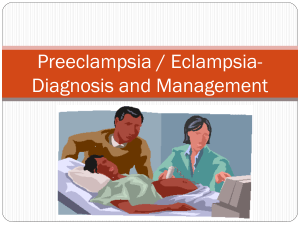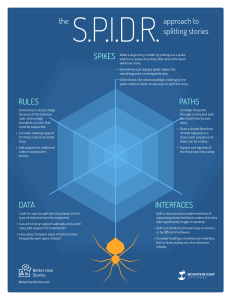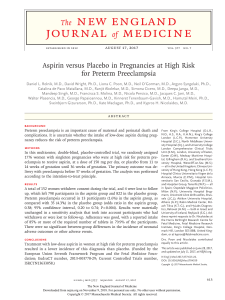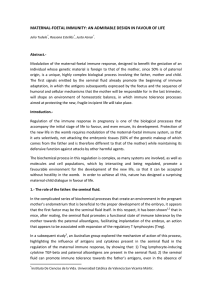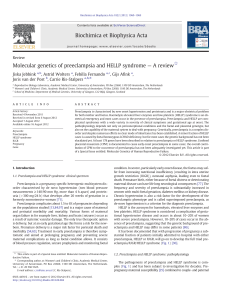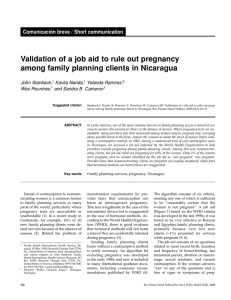10-workshops-on-Immunology-of-preeclamp 2017 Journal-of-Reproductive-Immunol
Anuncio
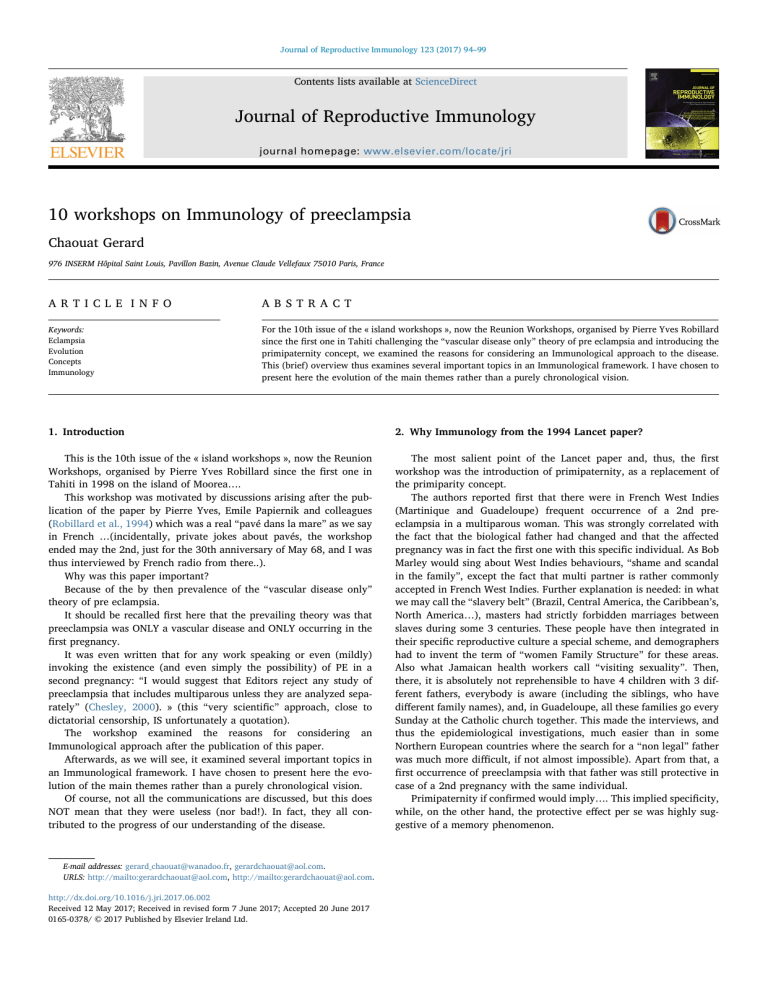
Journal of Reproductive Immunology 123 (2017) 94–99 Contents lists available at ScienceDirect Journal of Reproductive Immunology journal homepage: www.elsevier.com/locate/jri 10 workshops on Immunology of preeclampsia MARK Chaouat Gerard 976 INSERM Hôpital Saint Louis, Pavillon Bazin, Avenue Claude Vellefaux 75010 Paris, France A R T I C L E I N F O A B S T R A C T Keywords: Eclampsia Evolution Concepts Immunology For the 10th issue of the « island workshops », now the Reunion Workshops, organised by Pierre Yves Robillard since the first one in Tahiti challenging the “vascular disease only” theory of pre eclampsia and introducing the primipaternity concept, we examined the reasons for considering an Immunological approach to the disease. This (brief) overview thus examines several important topics in an Immunological framework. I have chosen to present here the evolution of the main themes rather than a purely chronological vision. 1. Introduction 2. Why Immunology from the 1994 Lancet paper? This is the 10th issue of the « island workshops », now the Reunion Workshops, organised by Pierre Yves Robillard since the first one in Tahiti in 1998 on the island of Moorea…. This workshop was motivated by discussions arising after the publication of the paper by Pierre Yves, Emile Papiernik and colleagues (Robillard et al., 1994) which was a real “pavé dans la mare” as we say in French …(incidentally, private jokes about pavés, the workshop ended may the 2nd, just for the 30th anniversary of May 68, and I was thus interviewed by French radio from there..). Why was this paper important? Because of the by then prevalence of the “vascular disease only” theory of pre eclampsia. It should be recalled first here that the prevailing theory was that preeclampsia was ONLY a vascular disease and ONLY occurring in the first pregnancy. It was even written that for any work speaking or even (mildly) invoking the existence (and even simply the possibility) of PE in a second pregnancy: “I would suggest that Editors reject any study of preeclampsia that includes multiparous unless they are analyzed separately” (Chesley, 2000). » (this “very scientific” approach, close to dictatorial censorship, IS unfortunately a quotation). The workshop examined the reasons for considering an Immunological approach after the publication of this paper. Afterwards, as we will see, it examined several important topics in an Immunological framework. I have chosen to present here the evolution of the main themes rather than a purely chronological vision. Of course, not all the communications are discussed, but this does NOT mean that they were useless (nor bad!). In fact, they all contributed to the progress of our understanding of the disease. The most salient point of the Lancet paper and, thus, the first workshop was the introduction of primipaternity, as a replacement of the primiparity concept. The authors reported first that there were in French West Indies (Martinique and Guadeloupe) frequent occurrence of a 2nd preeclampsia in a multiparous woman. This was strongly correlated with the fact that the biological father had changed and that the affected pregnancy was in fact the first one with this specific individual. As Bob Marley would sing about West Indies behaviours, “shame and scandal in the family”, except the fact that multi partner is rather commonly accepted in French West Indies. Further explanation is needed: in what we may call the “slavery belt” (Brazil, Central America, the Caribbean’s, North America…), masters had strictly forbidden marriages between slaves during some 3 centuries. These people have then integrated in their specific reproductive culture a special scheme, and demographers had to invent the term of “women Family Structure” for these areas. Also what Jamaican health workers call “visiting sexuality”. Then, there, it is absolutely not reprehensible to have 4 children with 3 different fathers, everybody is aware (including the siblings, who have different family names), and, in Guadeloupe, all these families go every Sunday at the Catholic church together. This made the interviews, and thus the epidemiological investigations, much easier than in some Northern European countries where the search for a “non legal” father was much more difficult, if not almost impossible). Apart from that, a first occurrence of preeclampsia with that father was still protective in case of a 2nd pregnancy with the same individual. Primipaternity if confirmed would imply…. This implied specificity, while, on the other hand, the protective effect per se was highly suggestive of a memory phenomenon. E-mail addresses: [email protected], [email protected]. URLS: http://mailto:[email protected], http://mailto:[email protected]. http://dx.doi.org/10.1016/j.jri.2017.06.002 Received 12 May 2017; Received in revised form 7 June 2017; Accepted 20 June 2017 0165-0378/ © 2017 Published by Elsevier Ireland Ltd. Journal of Reproductive Immunology 123 (2017) 94–99 C. Gerard All of the following workshops but one (held in Tiomian) were held in Réunion island, (where we had the chance to have one during an eruption of the Volcano, and to fly above it by helicopter) and always in the same place…., hotel Iloha at Saint Leu, which made interactions easy. Specific memory is a feature shared only by the immune and nervous system. The vascular theory, it was admitted, could explain the apparent protection (primigravidity), but had more difficulties in explaining the resurgence of the phenomenon in cases of a second occurrence linked to a change in biological father in multiparous women. 4. Evolutionary perspective 3. Setting some of the framework Why preeclampsia in human? And great apes? In the 1st Mauritius workshop, Jean Chaline suggested that preeclampsia might somehow be the price to pay by the human Homo Sapiens for a bigger brain…(Chaline, 2003). He reminded us of the existence of preeclampsia in some big apes (albeit the experimental work is rather small …. for obvious reasons when dealing with protected/endangered species, some being moreover territorially aggressive: gorillas) and insisted on the fact that there is TWO waves of invasion in human placentation, preeclampsia being characterised in the 2nd one by a « shallow invasion » – data of Pijnenborg, see for example Naicker et al. (2003). A part of the discussion later on, which is not fully settled yet, would be to establish if preeclampsia starts by then or, much earlier, around the implantation stage itself (see below). At this 2nd workshop, Jean Chaline presented his views on the extinction of Neanderthal, and the possible relationship with failure to develop a large and complex enough brain. The discussion went on about size of the brain and intelligence in such mammals as dolphins (an epitheliochorial placentation) and elephants, as well as on the preeclamptic (hemochorial placentation) great apes. I must stress that this discussion occurred before the discoveries that Neanderthal was much more technically and culturally developed than what was thought in the 90s, and the realisation that there were close relations between Neanderthal and Sapiens communities, and even exchange of artefacts (commerce) and, even more, interbreeding, (Temme et al., 2014; and for a relatively recent general overview, Gibbons, 2014). This has lead for example to a recent suggestion that disappearance of Neandertal would have resulted by “dilution” after a period of interbreeding…., but the ideas of genocides, acute competition, or inferior species as far as technology is concerned are no longer as dominant as they were by then. Nevertheless, this evolutionary vision led us also to examine the very concept that allopregnancy had to be considered as a possible materno foetal immune conflict. This lead to assess in depth Polly Matzinger remark “Reproduction cannot be a danger! it does not make evolutionary sense”. One must recall that it is precisely discussion about “non rejection of the foetal allograft” that lead Polly, during her discussions with Robert Schwab, of UCLA Davis, at a bar when she was then a cocktail waitress, to postulate that self/non self theory was wrong, and that the immune system was in fact reacting to the 4ds: danger, (“bad” cell) death (as opposite to “controlled cell death”, such as apoptosis), damage, and distress (Matzinger, 1994). Thus we invited Elisabeth Bonney (Bonney, 2016) and Colin Anderson. Though the danger model as such did not gain universal acceptance, their talk did cast further light on the importance of uncontrolled post implantation inflammation, as indeed seen in many cases of sterility and a subset of recurrent aborters. The discussions on evolution lead also later to comparative analysis of viviparous mammals. Eutherian M. Elliott recently focused on the relationship between oxidative stress and the evolution of placentation in eutherian mammals (Elliot, 2016). For him, epitheliochorial placentation, in which foetal tissues remain separated from maternal blood throughout gestation, has evolved as a protective mechanism against oxidative stress arising from 3.1. First workshop Wisely enough, since the “blood transfusion effect ” was known since 1981 and was less suspicious amongst Immunologists than disquisitions on the now defunct “I-J sub-region”, Pierre Yves and Gus had invited Paul Terasaki, well known for the blood transfusion effect in kidney transplantation (Tokunaga and Terasaki, 1986) which lead us to discuss the role of “suppressor T cells”, and we recalled that since the work of Loblay, Pritchard Briscoe and Basten “multiple low dose tolerance” – in this seminal paper, to Human Gamma Globulin”, was associated with “suppressor T cell memory” – (Loblay et al., 1978). This was of importance since the observation of the duration of sexual cohabitation enabled Gus Dekker to suggest the protective role of sperm exposure, and later on even question the protective effects of oral sex (Koelman et al., 2000), whereas Chris Redman was already there, and presented to us his views on inflammation as the cause of preeclampsia which he will develop all along the time course of the workshops till now, with adaptation to Immunology (see below). Both myself and Pierre Yves had the feeling that he was more interested at the start of the workshop by vascular theories but inclined at the end to discuss Immunological ones. 3.2. The 2nd workshop The 2nd workshop moved from the South Pacific to the Indian ocean, in that case Mauritius, due to the appointment of Pierre Yves in La Reunion, and thus his moving away from Tahiti/Moorea… Many of us who were there would of course remember the paradise like setting of the Moorea Lagoon… Further clues were added: the role of sperm was tackled again by Satish Gupta, and the first mention of HLA-G was made by Debra Wohl (down regulation of HLA-G in the placentae of preeclamptic women) (Goldman-Wohl et al., 2000). The first PE (artificially induced) animal model was introduced by Sasaki Hayakawa. It was a transfer of IL-12/IL-4 hyper-activated lymphocytes in pregnant mice and such abnormal activation of the innate immune system by selected cytokines did lead to a pre eclampsia like syndrome in mice (Hayakawa et al., 2000). Retrospectively, it is interesting to note that C3 deposits were observed in the kidneys of Il-4 treated animals, but this was not noticed enough at the time. 3.3. The continuation … From these two first workshops, the main discussion themes of the sessions to come were established. These were: • Evolutionary perspective • Primiparity/primipaternity sperm exposure • Diagnosis predictive (and indications for Therapy?): IPG VEGF • IMMUNOLOGY and the vessels, itself divided into: ○ NK • Complement • Induction of « tolerance » to the foetal allograft • Th1/Th2 cytokine unbalance • Tregs • The role of Inflammation, debris, small particles 95 Journal of Reproductive Immunology 123 (2017) 94–99 C. Gerard An important question arising about the consequences of these studies was whether the mother is primed to paternal alloantigens, and whether or not this does occur before, during, of after a 1st pregnancy and was discussed in the first workshops. In a way, the response was built in the study of Einarsson (the effects of using barrier prior to conception). Interestingly exposure to paternal seminal fluid as a reducing factor for preeclampsia needs not to be by the vaginal route, since exposure via the oral route will also confer a reduced risk of preeclampsia. Incidentally, an humoresque note was that we were told that the papers from this workshop using “oral sex” as keyword had an unusually high rate of visits (see the above referenced paper from Koelman et al.). Anyway, this linking of several anatomic compartments of mucosal immunity has to be related with, conversely the observations/theory suggesting that at least a part of recurrent abortions are linked to abnormal development the gut flora, resulting in a disequilibrium in the mucosal immune response. It may seem somehow funny that at one workshop oral sensitization by artificial MHC peptides was discussed, but in fact: why not? A related question is whether priming affects all or only some of the lymphocyte subpopulations. A set of data did provide evidence in rodents that a sort of priming occurs at mating, and this was extended by elegant studies of Sarah Robertson showing that T regs subpopulations were activated in an antigen specific fashion by the paternal sperm, with a key role to such cytokines as TGF – beta (Robertson et al., 2009). The cascade of immunological events elicited by seminal TGF beta may therefore explain epidemiological observations linking acute and cumulative exposure to semen with successful placental development and pregnancy outcome. This, of course, is to be linked with T regs (see later on). Peculiarly convincing was the Comparison of Indian and Creole populations in Mauritius, since the occurrence of preeclampsia is very different in Indian population, where the women tend to have a single partner, and the local Creole population, where, as in West Indies, there exist a high number of 2nd set preeclampsia linked to the frequent occurrence of multi sexual partnership (Poonyth et al., 2003). pregnancy, particularly in species with unusually long gestation periods and unusually large placentas. “Human beings comprise an unusual species that has the life history characteristics of an epitheliochorial species, but exhibits hemochorial placentation, in which foetal tissues come into direct contact with maternal blood. I argue that the risk of preeclampsia has arisen as a consequence of the failure of human beings to evolve epitheliochorial placentation”. This is not so far from the Jean Chaline original paper, and mixed somehow the deep invasion process and the oxidative stress theories of the origin of pre eclampsia (see below). For my part, I did re-examine the 1953 Medwar paradigm: it is phrased as “”some immunological and endocrinological problems raised by the evolution of viviparity in vertebrates. (Medawar, 1953). I found (to my great surprise) that not only did placental pregnancy did evolve/appear in many VERTEBRATE species (as well as very early in invertebrate evolution) but that despite the presence of allograft rejection capacity allo pregnancy was proceeding in almost all of them w/ o any apparent immunological confrontation problems (Chaouat, 2016). “Problems” did appear in eutherian mammals, with apparently (the literature is rather scarce) a lower intensity in epitheliochorial (be it diffuse or cotydelonary) and endothelio chorial placentae than in hemochorial ones, albeit the equine pregnancy offers signs of necrosis, haemorrhages and rejection but nevertheless proceed to term (this, incidentally, does not fit with the danger theory?) except in the case of intra species pregnancy such as the donkey in horse one (Allen and Stewart, 2001). In fact two evolutionary “bricolages” were used by viviparous mammals, once diverted frome egg laying ones, the monotremes (see platypus). For one branch, there is implantation but as soon as paternal MHC would appear on the placenta, the marsupials “deliver” and the conceptus moves to the marsupial pouch. Another strategy (ours) was to tame the immune system by attraction of regulatory T cells (see below). The bricolage used then, in our branch, the eutherians, was to use a non coding sequence gene as (CNS1) to promote attraction and/or? development of intra uterine regulatory T cells. CNS-1 is expressed ONLY in eutherian mammals, and its KO results in profound pregnancy wastage (Samstein et al., 2012). Another consequence of the coexistence of an “allo” conceptus with the innate immune system as early as Cambrian, the presence of lymphoid aggregates around uterine vessels as early as in viviparous shark placenta suggests/confirms the that the uterine NK cells were from the beginning NOT a “danger”. 6. Insulin resistance, inositol phosphoglycans A second point where there has been regular progress is the field of Inositol phosphoglycans story. I will only briefly summarize, since there is a full length review in this issue by the authors. At the beginning of the workshops, Thomas Rademacher presented first the measurements of the urinary content of inositol phosphoglycans IPG P-type and IPG A-type, putative insulin second messengers, in preeclampsia, as well as in the placenta from preeclamptic patients and from normal pregnancies. Pregnancy was associated with an increase in urinary IPG-P-type, a much higher level was seen in preeclamptic women. Later data confirmed the existence of this state of insulin resistance in active preeclampsia, but, moreover, a further step was to demonstrate that women with clinical evidence of insulin resistance were at higher risk to develop the syndrome. For a comprehensive overview, see Scioscia et al. (2011) and of course this issue of this journal. The next step was to test the populations in Mauritius on a large scale assay, and then, again in Mauritius, to test prospectively a kit permitting detection and measurement of such the development of preeclampsia. As discussed in the 2016 workshop, and in this issue, the results demonstrate that an easy, non invasive (urine) testing of women can allow the detection of these at risk for preeclampsia. Moreover, the results of this prospective study show that the detection of preeclampsia can be obtained rather early in pregnancy (Dawonauth et al., 2014). 5. Sperm tolerance, memory The second important topic was the role of sperm exposure and the concepts of primiparity vs. primi paternity. Several presentations dealt with that topic. I will give a few examples. The concept of primipaternity as well as the shorter the duration of sexual cohabitation the bigger the risk of PE after being discussed had of course to be confirmed, since it was a key issue leading to Immunology as well as the effects of sexual cohabitation, Several studies confirmed the importance of priming, and, moreover, its maintenance. In this respect, for example, a study by Einarsson and colleagues monitored the consequences of usage of barrier methods of contraception and indeed fewer than 4 months of cohabitation among users of barrier methods for contraception is associated with a significantly increased risk for preeclampsia (Einarsson et al., 2003). In addition, a study by D. Hall presented in 2006 was strongly suggestive that preeclampsia and gestational hypertension are less common in HIV infected women being managed with mono- or triple anti-retroviral therapy, a fact which they confirmed in 2014 (Hall et al., 2014), albeit the issue is still controversial (Adams et al., 2016). 7. VEGF Another marker has been discussed repeatedly, e.g. VEGF s Flt1. It 96 Journal of Reproductive Immunology 123 (2017) 94–99 C. Gerard has been first introduced together with Angiopoietin in human and murine immune abortion pathways (see below)and then as such by Anan Karumanchi in the 2006 workshop (Kopcow and Karumanchi, 2007). It should be recalled here (see below) that the regulation of angiogenic factors (VEGF, angiopoietin 2) in the regulation of placental growth was also initially linked to NK cells by Anne Croy (see below), who was the first to propose a role for such cells in preeclampsia (and presented that in one of the workshops) (Croy et al., 2000). In the 2006 edition, Karumanchi has shown that sFlt1 (soluble FMSlike tyrosine kinase1) is upregulated in preeclamptic patients blood, where it acts as a potent antagonist to VEGF and (PlGF). This (important) increase precedes the established preeclampsia and in fact can be detected prior to onset of clinical symptoms. Consistent with the action of the circulating protein to bind PIGF, free (or unbound) PlGF levels are decreased in preeclamptic women, also well before the onset of clinical symptoms. Thus, we dispose of a second predictive test, albeit slightly more invasive than an urine sampling. Etiologically speaking dysregulation of other anti-angiogenic agents such as sFlt-1, e.g. PLGF and sEndoglin was also examined by Foidart, who nevertheless concluded that such a deregulation was “not the definitive answer” (Foidart et al., 2009). It should be pointed out that, such a deregulation can be integrated in a purely vascular theory, where a poor placentation would be leading to poor uteroplacental perfusion and hypoxia, which would in turn stimulatessFlt-1 and sEng production causing the maternal syndrome However, as Foidart pointed, whereas the deregulations are real, this theory would suggest that, antioxidant therapy could prevent PE, but the data concerning the effects of such a treatment so far are “at best conflicting”. Linked to that, anyway, it was shown that Impaired autophagy of extravillous trophoblast (EVT) by soluble endoglin may disturb EVT invasion and vascular remodelling. uNK KIR interactions (Hiby et al., 2004). They classified HLA-C in different groups −It should be recalled here that near onset of the workshops, HLA-C was perceived by several workers as quasi monomorphic, which it was recalled several times, it is not. In fact, Hiby proved that a proper activating signal from maternal KIR was beneficial if HLA-C Group 2 is present in the fetus. The data were completed by a study of KIR AA genotype and HLA-C2 frequencies in different populations in the world, showing a reciprocal relationship between AA frequency and HLA-C2 frequency. It must be mentioned, however, that despite the generalisation of this interaction as important in the pathology of recurrent abortions and low birth weight by the same group years afterwards. Shigeru Saito presented data comparing the two types of couples in Japan, and that “the incidence of pre-eclampsia in these couples consisting of Japanese women and Caucasian men was similar to that in Japanese women and Japanese men. Our data do not support that of Hiby et al.” (Saito et al., 2006), but the authors replied that in their opinion the Japanese study was statistically flawed (Moffett et al., 2006). See reply by the authors in Saito and Sakai (Saito and Sakai, 2016). 9. Of mice and men… Complement …. For years, anyway, the CBA x DBA/2 murine mating combination was presented solely as an immune abortion model…. and even by me, that despite a paper pointing “Immunological similarities between implantation and pre-eclampsia » (Chaouat et al., 2005)….: mice were never tested for albuminuria nor blood pressure… Guillermina Girardi did that, and nicely showed that symptoms of preeclampsia were present in first pregnancy of this mating combination. Moreover, and this is important, this was correlated with alterations in local angiogenesis and local angiogenic factors production. Even most important, a variety of treatments affecting complement activation did prevent both pregnancy loss and ‘clinical’ and biological preeclampsia symptoms. These were ip injection of recombinant CrryIg, or anti-C5 MoAB on days 4 and 6, or a C5aR cyclic antagonist peptide. Alternative pathway activation was inhibited by administering anti–factor B mAb (2 mg i.p.) on days 4–10 of pregnancy. All these treatments resulted in a correction of the CBA x DBA/2 pregnancy pathologies. (Girardi, 2009; Ahmed et al., 2010) Moreover, she was able to demonstrate a crucial role for tissue injury and proposed prevastatin treatment in consequence, and indeed this prevented preeclamptic syndrome in CBA × DBA/2 murine matings (and corrected the associated VEGF deregulations, decreasing sFlt1 levels and increasing VEGF levels). It should be recalled here that independently a Japanese group reported correction of a preeclamptic syndrome artificially induced by expression of human sFLT1 (hsFLT1) specifically in the murine placenta using a pravastatin treatment (Kumasawa et al., 2011). Additionally, it was shown that statins induce Hmox1 and suppress the release of sFlt-1 and sEng. Thus, statins and Hmox1 activators were seen as potential novel therapeutic agents for treating preeclampsia, and indeed randomised control trials were initiated. It should be mentioned in this review that a very limited (4 women) open study produced apparently positive results. For more data, see this Journal issue. For our own, we tested in cooperation with Francesco Tedesco very early the role of MBL as a complement activator initiating pregnancy loss, or implantation defects, or preeclampsia, in mice and human. Indeed, blocking MBL, and in case of mice, MBL-A, resulted in prevention of these syndromes (Petitbarat et al., 2015). This set of data also offers a link towards abnormal NK activation at the interface. Albeit uNK cells are normally non cytotoxic and essentially angiogenic, an abnormal NK activation can occur in the periphery, and the ds 8. NK cells Whatever the effects, anyway, those data pointed out to a role of angiogenic mediators. It was in this respect that the role of the uterine NK cells was tackled. At the onset of the workshops, NK, and hyper activation of these, were seen mostly, if not exclusively, as a threat towards the embryo. The data were clear cut in mice and rat immune abortion models, much less clear and conflicting in human (especially when regarding the need to “tame down” (quote) uterine and circulating NK cells, especially by lymphocyte Immunisation (lymphocyte immunotherapy protocols in case of either implantation failure or recurrent spontaneous abortions…). However, when dealing with implantation, it became evident the pre and peri implantation uterus was filled with uterine NK cells and that these cells were somehow activated… This apparently appeared as a contradiction which was resolved by Anne Croy who demonstrated that uterine NK cells are not only “normally” non cytotoxic, but, in fact are a main source of angiopoietin 2, critical itself to destabilisation of uterine arteries and their subsequent transformation into spiral arteries. Indeed, NK −/− mice do implant BUT abort around day 9.56 and that this can be prevented by transferring normal NKs (Croy et al., 2003). Further to this major step, in parallel the acronym KIR = Killer Inhibitoy receptor was replaced in the literature by the use of KIR as an acronym for Killer Ig like Receptor (this has Created for a time some confusion…). The demonstration that activation of the “activating KIRS” on the uterine NKs leads to the secretion by uNK cells of angiogenic factors was then linked also to the stimulatory role of the placental paternal MHC by the important results of Hiby et al., dealing with HLA-C and 97 Journal of Reproductive Immunology 123 (2017) 94–99 C. Gerard specific activated T regs correct abortion and 1st pregnancy induced albuminuria in the CBA x DBA/2 system. See for example out work in cooperation with David Klatmann (Chen et al., 2013). RNA injection systems (POLY IC, Poly I C14U) are good models to study such effects. But it has also been proposed that the effects can be local, and IL-17 and TH-17 cells have been proposed to be one of those activation pathways. Moreover, it has also been shown that uNK do not exhibit a “fixed phenotype”. Le Bouteiller et al. demonstrated in decidual NML cells that the specific engagement of NKp46-, and to a lesser extent of NKG2C-, but not of NKp30-activating receptors induced intracellular calcium mobilization, perforin polarization, granule exocytosis and efficient target cell lysis Thus, uterine NK cells CAN become cytotoxic (El Costa et al., 2009). A crucial role for NK/and activated T cell inhibition/destruction by apoptosis by HLA-G was a regular opic of the workshops, and as stated down regulation of HLA-G production, and or expression in the placentae of preeclamptic women has been reported by several authors in these workshops; whereas the mechanisms of action of HLA-G on NK and T cells has been shown to rely not only on its membrane bound isoforms, but also, and perhaps more importantly on soluble ones. Moreover, sHLA-G have been shown to not only play a role in inhibition of local cytotoxic pathways, but, most important, in control of local angiogenesis, and uterine arteries remodelling and extension (Le Bouteiller et al., 2007). An important feature of the complement inhibition data is that a protection can be offered by a treatment as early as day 4 in mice, e.g. at the very peri implantation period, and not as late as the initially thought to be predominant, TNF, gamma INF and activated macrophages classical “resorption window” of the CBA x DBA/2 murine mating combination. 12. Conclusion Thus, we come to an integrated scheme, and albeit I disagree partly with Chris Redman when he says “the reactivity to fetal alloantigens are not really in cause”, his 2010 abstract merits to be quoted as a conclusion, and the last sentence highlighted: “Pre-eclampsia develops in stages, only the last being the clinical illness. This is generated by a non-specific, systemic (vascular), inflammatory response, secondary to placental oxidative stress and not by reactivity to fetal alloantigens. However, maternal adaptation to fetal (paternal alloantigens) is crucial in the earlier stages. A preconceptual phase involves maternal tolerization to paternal antigens by seminal plasma. After conception, regulatory T cells, interacting with indoleamine 2,3-dioxygenase, together with decidual NK cell recognition of foetal HLA-C on extravillous trophoblast may facilitate placental growth by immunoregulation. Complete failure of this mechanism would cause miscarriage, while partial failure would cause poor placentation and dysfunctional uteroplacental perfusion. The first pregnancy preponderance and partner specificity of pre-eclampsia can be explained by this model. For the first time, the pathogenesis of pre-eclampsia can be related to defined immune mechanisms that are appropriate to the fetomaternal frontier. Now, the challenge is to prove the detail »”. References 10. “Its all inflammation, stupid !” Adams, J.W., Watts, D.H., Phelps, B.R., 2016. A systematic review of the effect of HIV infection and antiretroviral therapy on the risk of pre-eclampsia. Int. J. Gynaecol. Obstet. 133 (1), 17–21. Ahmed, A., Singh, J., Khan, Y., Seshan, S.V., Girardi, G., 2010. A new mouse model to explore therapies for preeclampsia. PLoS One 27 (October (5)), 10. Allen, W.R., Stewart, F., 2001. Equine placentation. Reprod. Fertil. Dev. 13 (7–8), 623–634. Aluvihare, V.R., Kallikourdis, M., Betz, A.G., 2004. Regulatory T cells mediate maternal tolerance to the fetus. Nat. Immunol. 5, 266–271. Bonney, E.A., 2007. Preeclampsia: a view through the danger model. J. Reprod. Immunol. 76 (1–2), 68–74. Chaline, J., 2003. Increased cranial capacity in hominid evolution and preeclampsia. J. Reprod. Immunol. 59 (2), 137–152. Chaouat, G., Ledée-Bataille, N., Dubanchet, S., 2005. Immunological similarities between implantation and pre-eclampsia. Am. J. Reprod. Immunol. 53 (5), 222–229. Chaouat, G., 2016. Reconsidering the Medawar paradigm placental viviparity existed for eons, even in vertebrates; without a ‘problem’: Why are Tregs important for preeclampsia in great apes? J. Reprod. Immunol. 114, 48–57. Chen, T., Darrasse-Jèze, G., Bergot, A.S., Courau, T., Churlaud, G., Valdivia, K., Strominger, J.L., Ruocco, M.G., Chaouat, G., Klatzmann, D., 2013. Self-specific memory regulatory T cells protect embryos at implantation in mice. J. Immunol. 191 (5), 2273–2281 1. Chesley, L.C., 2000. Recognition of the long-term sequelae of eclampsia. Am. J. Obstet. Gynecol. 182, 249–250 (1 Pt 1). Croy, B.A., Ashkar, A.A., Minhas, K., Greenwood, J.D., 2000. Can murine uterine natural killer cells give insights into the pathogenesis of preeclampsia? J. Soc. Gynecol. Investig. 7 (1). Croy, B.A., Esadeg, S., Chantakru, S., van den Heuvel, M., Paffaro, V.A., He, H., Black, G.P., Ashkar, A.A., Kiso, Y., Zhang, J., 2003. Update on pathways regulating the activation of uterine Natural Killer cells, their interactions with decidual spiral arteries and homing of their precursors to the uterus. J. Reprod. Immunol. 59 (2), 175–191. Dawonauth, L., Rademacher, L., L'Omelette, A.D., Jankee, S., Lee Kwai Yan, M.Y., Jeeawoody, R.B., Rademacher, T.W., 2014. Urinary inositol phosphoglycan-P type: near patient test to detect preeclampsia prior to clinical onset of the disease. A study on 416 pregnant Mauritian women. J. Reprod. Immunol. 101–102, 148–152. Einarsson, J.I., Sangi-Haghpeykar, H., Gardner, M.O., 2003. Sperm exposure and development of preeclampsia. Am. J. Obstet. Gynecol. 188 (5), 1241–1243. El Costa, H., Tabiasco, J., Berrebi, A., Parant, O., Aguerre-Girr, M., Piccinni, M.P., Le Bouteiller, P., 2009. Effector functions of human decidual NK cells in healthy early pregnancy are dependent on the specific engagement of natural cytotoxicity receptors. J. Reprod. Immunol. 82 (2), 142–147. Elliot, M.G., 2016. Oxidative stress and the evolutionary origins of preeclampsia. J. Reprod. Immunol. 114, 75–80. Foidart, J.M., Schaaps, J.P., Chantraine, F., Munaut, C., Lorquet, S., 2009. Dysregulation This suggested that the initial events in murine models and human pathologies of preeclampsia could take place very early. In this respect, continuous studies of the (hyper) inflammation process, trophoblast damage, and micro particles shedding by the group of Redman and Sargent are very important. Besides recalling that “It’s all inflammation, stupid” (original title of one presentation in 2010) and the micro-vesicles are to blame” – see (Redman and Sargent, 2007), the group has proposed that in fact pre eclampsia is a multi stage disorder, starting indeed very early (Redman, 2014). This conceptual evolution from the Tahiti workshop to the last one is certainly better tackled by CWG Redman than myself, and I refer to his paper in this issue. It does not neglect such factors as complement regulators, etc… as discussed in this brief overview as “tamers” of such an inflammation, and amongst such tamers are T regs. 11. T regs A salient feature of the primipaternity model is the specific protection offered by a first same partner pregnancy to the following conceptions, as well as the effects of long cohabitation, and eventually additional effects of oral sex. The ideal candidates for such a memory effect were proposed as early as the 1st meeting to be “suppressor T cells”. Following the “resurrection” of these as regulatory T cells after the work of S Sakaguchi (Sakaguchi et al., 1985), and especially in view of their important role in pregnancy as initially demonstrated by Aluvihare and Betz (Aluvihare et al., 2004), these have been extensively studied in the frame of these workshops, and there seems to be a consensus that they indeed play a cardinal role, albeit possibly not solely, since it has been shown that “Decidual NK cells remember pregnancy”. Adoptive transfer of Tregs, for example, or their expansion by a controlled low dose treatment of Interleukin 2 corrects abortion in murine abortion models, and we have verified that transfer of paternal 98 Journal of Reproductive Immunology 123 (2017) 94–99 C. Gerard Moffett, A., Hiby, S., Carrington, M., 2006. The incidence of pre-eclampsia among couples consisting of Japanese women and Caucasian men. J. Reprod. Immunol. 71 (2), 132–133. Naicker, T., Khedun, S.M., Moodley, J., Pijnenborg, R., 2003. Quantitative analysis of trophoblast invasion in preeclampsia. Acta Obstet. Gynecol. Scand. 82 (8), 722–729. Petitbarat, M., Durigutto, P., Macor, P., Bulla, R., Palmioli, A., Bernardi, A., De Simoni, M.G., Ledee, N., Chaouat, G., Tedesco, F., 2015. Critical role and therapeutic control of the lectin pathway of complement activation in an abortion-prone mouse mating. J. Immunol. 195 (12) 5602. Poonyth, L., Sobhee, R., Soomaree, R., 2003. Epidemiology of preeclampsia in Mauritius island. J. Reprod. Immunol. 59 (2), 101–109. Redman, C.W., Sargent, I.L., 2007. Microparticles and immunomodulation in pregnancy and pre-eclampsia. J. Reprod. Immunol. 76 (1–2), 61–67. Redman, C., 2014. The six stages of pre-eclampsia. Pregnancy Hypertens 4 (3), 246. Robertson, S.A., Guerin, L.R., Moldenhauer, L.M., Hayball, J.D., 2009. Activating T regulatory cells for tolerance in early pregnancy – the contribution of seminal fluid. J. Reprod. Immunol. 83 (1–2), 109–116. Robillard, P.Y., Hulsey, T.C., Périanin, J., Janky, E., Miri, E.H., Papiernik, E., 1994. Association of pregnancy-induced hypertension with duration of sexual cohabitation before conception. Lancet 344 (8928), 973–975. Saito, S., Sakai, M., 2016. Reply from the authors. J. Reprod. Immunol. 71 (2), 13. Saito, S., Takeda, Y., Sakai, M., Nakabayahi, M., Hayakawa, S., 2006. The incidence of pre-eclampsia among couples consisting of Japanese women and Caucasian men. J. Reprod. Immunol. 70 (1–2), 93–98. Sakaguchi, S., Fukuma, K., Kuribayashi, K., Masuda, T., 1985. Organ-specific autoimmune diseases induced in mice by elimination of T cell subset. I. Evidence for the active participation of T cells in natural self-tolerance; deficit of a T cell subset as a possible cause of autoimmune disease. J. Exp. Med. 161 (1), 72–87. Samstein, R.M., Josefowicz, S.Z., Arvey, A., Treuting, P.M., Rudensky, A.Y., 2012. Extrathymic generation of regulatory T cells in placental mammals mitigates maternal-fetal conflict. Cell 150 (1), 29–38. Scioscia, M., Williams, P.J., Gumaa, K., Fratelli, N., Zorzi, C., Rademacher, T.W., 2011. Inositol phosphoglycans and preeclampsia: from bench to bedside. J. Reprod. Immunol. 89 (2), 173–177. Temme, S., Zacharias, M., Neumann, J., Wohlfromm, S., König, A., Temme, N., Springer, S., Trowsdale, J., Koch, N., 2014. A novel family of human leukocyte antigen class II receptors may have its origin in archaic human species. J. Biol. Chem. 289 (2), 639–653 10. Tokunaga, K., Terasaki, P.I., 1986. The transfusion effect. Clin. Transpl. 17, 5–88. of anti-angiogenic agents (sFlt-1, PLGF, and sEndoglin) in preeclampsia-a step forward but not the definitive answer. J. Reprod. Immunol. 82 (2), 106–111. Gibbons, A., 2014. Human evolution. Oldest Homo sapiens genome pinpoints Neandertal input. Science 343 (6178), 1417 28. Girardi, G., 2009. Pravastatin prevents miscarriages in antiphospholipid antibody-treated mice. J. Reprod. Immunol. 82 (2), 126–131. Goldman-Wohl, D.S., Ariel, I., Greenfield, C., Hochner-Celnikier, D., Cross, J., Fisher, S., Yagel, S., 2000. Lack of human leukocyte antigen-G expression in extravillous trophoblasts is associated with pre-eclampsia. Mol. Hum. Reprod. 6 (1), 88–95. Hall, D., Gebhardt, S., Theron, G., Grové, D., 2014. Pre-eclampsia and gestational hypertension are less common in HIV infected women. Pregnancy Hypertens 4 (1), 91–96. Hayakawa, S., Fujikawa, T., Fukuoka, H., Chisima, F., Karasaki-Suzuki, M., Ohkoshi, E., Ohi, H., Kiyoshi Fujii, T., Tochigi, M., Satoh, K., Shimizu, T., Nishinarita, S., Nemoto, N., Sakurai, I., 2000. Murine fetal resorption and experimental pre-eclampsia are induced by both excessive Th1 and Th2 activation. J. Reprod. Immunol. 47 (2), 121–138. Hiby, S.E., Walker, J.J., O'Shaughnessy, K.M., Redman, C.W.G., Carrington, M., Trowsdale, I., Moffett, A., 2004. Combinations of maternal KIR and fetal HLA-C genes influence the risk of pre-eclampsia and reproductive success. J. Exp. Med. 200, 957–965. Koelman, C.A., Coumans, A.B., Nijman, H.W., Doxiadis, I.I., Dekker, G.A., Claas, F.H., 2000. Correlation between oral sex and a low incidence of preeclampsia: a role for soluble HLA in seminal fluid? J. Reprod. Immunol. 46 (2), 155–166. Kopcow, H.D., Karumanchi, S.A., 2007. Angiogenic factors and natural killer (NK) cells in the pathogenesis of preeclampsia. J. Reprod. Immunol. 76 (1–2), 23–29. Kumasawa, K., Ikawa, M., Kidoya, H., Hasuwa, H., Saito-Fujita, T., Morioka, Y., Takakura, N., Kimura, T., Okabe, M., 2011. Pravastatin induces placental growth factor (PGF) and ameliorates preeclampsia in a mouse model. Proc. Natl. Acad. Sci. U. S. A. 108 (4), 1451–1455 25. Le Bouteiller, P., Fons, P., Herault, J.P., Bono, F., Chabot, S., Cartwright, J.E., 2007. Bensussan A: soluble HLA-G and control of angiogenesis. J. Reprod. Immunol. 76 (December (1–2)), 17–22. Loblay, R.H., Pritchand-Briscoe, H., Basten, A., 1978. Suppressor T-cell memory. Nature 272 (5654), 620–622. Matzinger, P., 1994. Tolerance, danger, and the extended family. Annu. Rev. Immunol. 12, 991–1045. Medawar, P., 1953. Some immunological and endocrinological problems raised by the evolution of viviparity in vertebrates. Symp. Soc. Exp. Biol. 7, 320–338. 99
